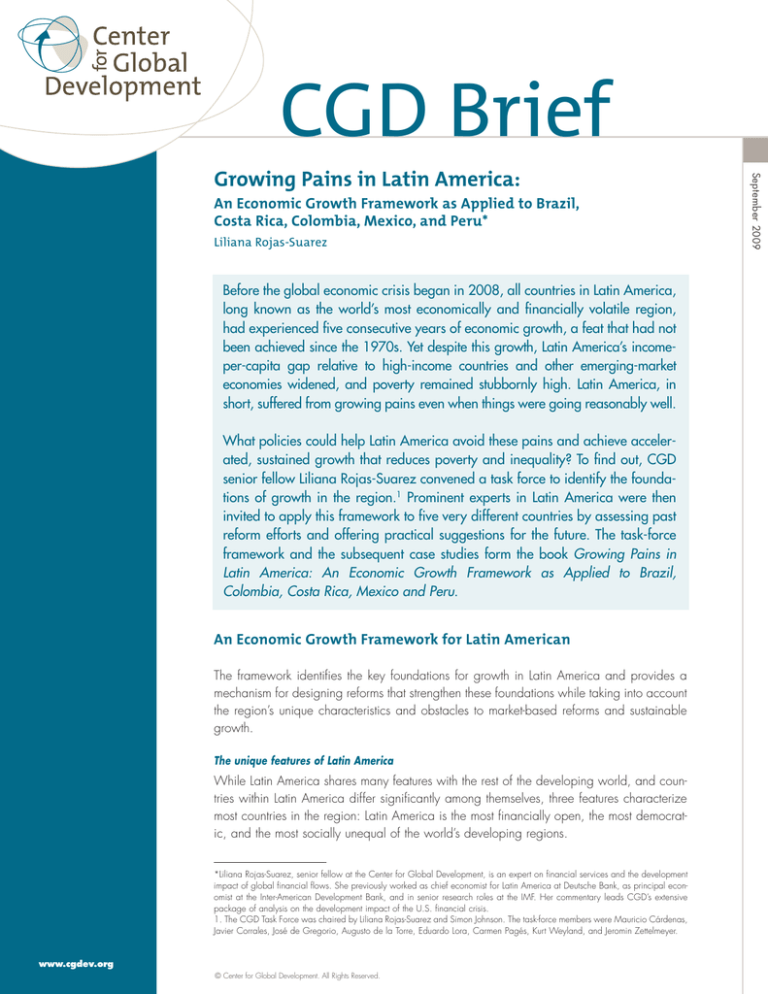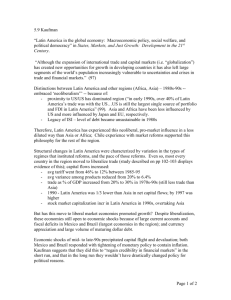
CGD Brief
An Economic Growth Framework as Applied to Brazil,
Costa Rica, Colombia, Mexico, and Peru*
Liliana Rojas-Suarez
Before the global economic crisis began in 2008, all countries in Latin America,
long known as the world’s most economically and financially volatile region,
had experienced five consecutive years of economic growth, a feat that had not
been achieved since the 1970s. Yet despite this growth, Latin America’s incomeper-capita gap relative to high-income countries and other emerging-market
economies widened, and poverty remained stubbornly high. Latin America, in
short, suffered from growing pains even when things were going reasonably well.
What policies could help Latin America avoid these pains and achieve accelerated, sustained growth that reduces poverty and inequality? To find out, CGD
senior fellow Liliana Rojas-Suarez convened a task force to identify the foundations of growth in the region.1 Prominent experts in Latin America were then
invited to apply this framework to five very different countries by assessing past
reform efforts and offering practical suggestions for the future. The task-force
framework and the subsequent case studies form the book Growing Pains in
Latin America: An Economic Growth Framework as Applied to Brazil,
Colombia, Costa Rica, Mexico and Peru.
An Economic Growth Framework for Latin American
The framework identifies the key foundations for growth in Latin America and provides a
mechanism for designing reforms that strengthen these foundations while taking into account
the region’s unique characteristics and obstacles to market-based reforms and sustainable
growth.
The unique features of Latin America
While Latin America shares many features with the rest of the developing world, and countries within Latin America differ significantly among themselves, three features characterize
most countries in the region: Latin America is the most financially open, the most democratic, and the most socially unequal of the world’s developing regions.
*Liliana Rojas-Suarez, senior fellow at the Center for Global Development, is an expert on financial services and the development
impact of global financial flows. She previously worked as chief economist for Latin America at Deutsche Bank, as principal economist at the Inter-American Development Bank, and in senior research roles at the IMF. Her commentary leads CGD’s extensive
package of analysis on the development impact of the U.S. financial crisis.
1. The CGD Task Force was chaired by Liliana Rojas-Suarez and Simon Johnson. The task-force members were Mauricio Cárdenas,
Javier Corrales, José de Gregorio, Augusto de la Torre, Eduardo Lora, Carmen Pagés, Kurt Weyland, and Jeromin Zettelmeyer.
www.cgdev.org
© Center for Global Development. All Rights Reserved.
September 2009
Growing Pains in Latin America:
Chinn Ito Financial Openness Index
Figure 1. Financial openess
2.5
2.0
High Income Countries
1.5
1.0
Latin America
& Caribbean
0.5
0.0
–0.5
–1.0
–1.5
–2.0
1970 1975 1980 1985 1990 1995 2000 2005 2006
Year
East Asia & Pacific
High Income
South Asia
Eastern Europe & Central Asia
Latin America & Caribbean
Sub-Saharan Africa
Source: Chinn and Ito (2007).
Figure 2. Democracy
7
6
Political Rights Index
Growing Pains
2
5
4
3
2
Latin America
& Caribbean
High Income Countries
1
0
1973 1975 1980 1985 1990 1995 2000 2005 2008
Year
East Asia & Pacific
High Income
South Asia
Source: Freedom House.
Eastern Europe & Central Asia
Latin America & Caribbean
Sub-Saharan Africa
Latin America’s financial openness, which
began with the securitization of government
debt under the Brady Plan in the late 1980s,2
has increased both its financing capacity and
its vulnerability to changes in investors’ perceptions of a country’s creditworthiness. The
preference in most Latin American countries for
a liberalized capital account means that
macroeconomic indicators must be stable at
all times, since any deviation will quickly
increase the perception of risk, causing capital
inflows to reverse and interest-rate spreads to
widen, to the detriment of investment and
growth. A successful framework for growth
must account for these facts.
By several measures, Latin America is the most
democratic region of the developing world.
Latin America’s democratization, on the rise
since the 1970s, is due largely to the decline
of military regimes. Like financial openness,
the region’s level of democracy must influence
any framework for growth; some reforms, for
example, might not be sustainable if a significant proportion of voters do not share in the
benefits. Also, any backlash against marketbased reforms can be expressed through
democratic processes and undermine the
chances of further reform.
Skepticism about reforms is a consequence of
the region’s high inequality. Latin America has
persistently had one of the most unequal income
distributions since the 1960s, even exceeding
that of sub-Saharan Africa in 2005. Evidence
suggests that income inequality over a certain
level is likely to reduce growth, in general, and
stymie the reform process in Latin America, in
particular.3
2. The Brady Plan was implemented in 1989 in response to the developing-country debt crises of the 1980s. The Brady Plan provided debt relief, contingent upon economic
reform, and allowed countries to issue highly tradable securitized debt.
3. Nancy Birdsall, “Income Distribution: Effects on Growth and Development,” CGD Working Paper 118 (Center for Global Development, 2007).
1. Secure property rights for the majority of the
population, so that individuals and firms can
benefit from their investments
2. Sufficiently equal opportunities for broad
segments of society, so that individuals and
firms without political connections or great
wealth can enter the market
3. Sufficient economic and political competition, to avoid capture of the state by powerful elites
60
Latin America
& Caribbean
55
50
45
40
35
30
High Income Countries
25
20
1960
1970
1980
1990
2000
2005
Year
East Asia & Pacific
High Income
South Asia
Eastern Europe & Central Asia
Latin America & Caribbean
Sub-Saharan Africa
Source: Rojas-Suarez (2009), Growing Pains in Latin America, based on data from
WIDER WIID2a and WDI–WB.
In Latin America, the combination of the region’s high financial openness, limited trade openness, underdeveloped
local financial markets, and low national savings rates
leads to the fourth foundation for growth:
5. Broad sharing of the benefits from growth, to ensure that
market-based reforms and policies conducive to growth
are sustainable
The framework: making the foundations for growth work
4. Macroeconomic stability, to avoid recessions and fiscal
adjustments that generally lead to cuts in social expenditure and infrastructure spending. In contrast to industrial
countries, a slight departure from macroeconomic stability in many Latin American countries quickly leads to a deterioration in investors’ confidence in policymakers’ capacity
to deal with the problems effectively and promptly
The fifth foundation reflects the need to reconcile marketbased reform with the discontent that large segments of the
population have with the market system:
What sets this framework apart from others is its incorporation of the three distinguishing features of Latin America: its
greater financial openness, its greater democracy, and its
greater inequality.4 Table 1 (next page) lists several of the
main areas of reform and indicates which of the foundations
for growth each area of reform has the potential to affect.
(This is a summary assessment derived from a review of the
literature on the effects of individual reforms on growth. It
should be taken to be illustrative, not representative of every
case and circumstance.)
4. While the framework as designed to be specific to Latin America, it has much in common with other important contributions to the literature on the search for “foundations
for economic growth.” See, for example, Ricardo Hausmann, Dani Rodrik, and Andrés Velasco, “Growth Diagnostics” (John F. Kennedy School of Government, Harvard
University, 2005) and Commission on Growth and Development, The Growth Report: Strategies for Sustained Growth and Inclusive Development (World Bank, 2008). In
Nancy Birdsall, Augusto de la Torre, and Rachel Menezes, Fair Growth: Economic Policies for Latin America’s Poor and Middle-Income Majority (Center for Global
Development and Inter-American Dialogue, 2008), the authors present a toolkit for policymakers to achieve growth on an equitable basis.
September 2009
The high degree of financial openness in Latin
America allows market forces, through the
behavior of the international capital markets,
to assess the performance of its economies.
The first basic foundations are therefore those
that create incentives for the appropriate functioning of markets in all market-based economies:
3
Figure 3. Income Inequality
Income Gini Coefficient
The five foundations for growth
Growing Pains
4
Table 1. Potential Impact of Selected Reforms on the Foundations for Growth
Reform
Property
rights
Equal
opportunity
Competition
Macroeconomic
stability
Broad sharing of
growth benefits
✓
✓✓
?
?
✓
✓✓
✓
Trade
Financial
✓
✓
Labor
✓
✓✓
Pension
✓
✓✓
✓✓
?
Privatization with regulationa
✓
✓
✓
✓
✓✓
✓
✓
✓✓
Budgetary institutions
✓
Educationb
✓
✓
✓
Fiscal Decentralization
?
?
Tax reform
?
✓
✓
✓
✓
✓✓
✓
✓
✓
✓
✓
✓
✓
✓
Judiciary
Electoral process
✓✓
Legislative
✓
✓
✓
✓
✓
Anti-corruption
✓
✓
✓
✓
✓
Note: One checkmark indicates a positive potential impact of the indicated reform on the indicated foundation, two checkmarks a strong positive impact, a
question mark an uncertain or mixed impact, and a blank cell no impact.
a. The table illustrates the potential impact of telecommunications privatization; privatization of other state enterprises might have somewhat different impacts.
b. Reform of other social services (for example, health care) would likely have similar impacts.
The main conclusion from the literature is that well-designed
and adequately implemented reforms in a variety of areas
can indeed contribute to sustainable growth. In practice,
however, past reforms have not always lived up to their
potential to strengthen the five growth foundations.
der the reform undesirable), problems of design (incomplete or poor implementation, misaligned incentives), and problems due to local conditions (such as inequality, adverse
political dynamics, insufficient implementation capacity, or
a deep vulnerability to external shocks).
Obstacles to growth in Latin America: the
framework applied to Brazil, Colombia,
Costa Rica, Mexico, and Peru
Once the constraints and obstacles to reform have been
identified, the question then becomes what to do about
them. This is the core of the case study analyses, each authored by a different group of experts.
Obstacles can either prevent reforms from being enacted in
the first place or dull the effect of enacted reforms. When
implemented reforms fail to realize their potential, the failure can generally be attributed to one or more of three possible problems: problems of relevance (the country is not
ready for the reform or particular features of the country ren-
Case studies of Brazil, Colombia, Costa Rica, Mexico, and
Peru first apply the framework for growth to assess past and
current reforms and then make recommendations for future
reform efforts. Each case study emphasizes policy recommendations that are both economically and politically feasible.
Brazil
Today, macroeconomic stability is the most crucial missing
foundation, closely followed by secure property rights, due
to the current system of high public expenditure. To enhance stability, Castelar Pinheiro, Bonelli, and Pessôa suggest
reforming fiscal policies to reduce public consumption and
tax policies to decrease the current tax burden. They recommend reforming the judiciary to strengthen property rights,
which have been weakened by past judicial reforms that
increased the independence of the judiciary. In Brazil’s judicial system, contracts are constantly breached and rulings
delayed by politically motivated judges. The authors propose, among other actions, using performance indicators
rather than seniority as the basis for judicial promotions,
indexing judicially imposed obligations and debt to the policy interest rate (best known as the SELIC) to reduce the
financial incentives of delaying final court rulings, and raising public awareness of the consequences of poor judicial
performance for economic development and social equity.
Colombia
ROBERTO STEINER, IRENE CLAVIJO, AND NATALIA SALAZAR
In 1990, Colombia embarked on a comprehensive reform
program, but the initial drive for reform failed to deliver on
many of its promises, and some reforms actually weakened
foundations for growth. After 1999, however, the reform
agenda was reinvigorated, and many of the initial design
problems were addressed. This process, coupled with a
benign external environment and a much-improved security
situation, produced economic growth and sparked a renewed decline in poverty. But additional reforms were still nee-
ded to make growth sustainable and more inclusive, and
the current international financial crisis has stalled any post1999 progress. To get Colombia back on track, Steiner,
Clavijo, and Salazar suggest addressing weaknesses in
economic and political competition, equal opportunities,
and the broad sharing of the benefits from growth, for
which they recommend tax reform, deepening of the financial sector, political and labor-market reforms, and political
and fiscal decentralization.
They also recommend three judicial reforms to curtail the
excessive judicial activism in the Constitutional Court, which
interferes with economic matters in general and with macroeconomic stability in particular.
First, lessen the politicization of court magistrates by allowing them to run for a second term, after a cool-off period of
perhaps five years. Under the current system, magistrates
may not be reelected, but they face practically no restrictions on their involvement elsewhere in politics after their
tenure.
Second, seek a consensus definition of what constitutes
adequate health care and other social services so that
judges cannot decree the provision of services beyond the
agreed-upon plans.
Finally, have the Constitutional Court review laws as soon
as they are approved, so that any overturning on procedural grounds would occur before the law takes effect.
Costa Rica
JORGE CORNICK AND ALBERTO TREJOS
Despite Costa Rica’s mostly positive economic-policy performance since the 1980s crisis, economic reform has lately become increasingly difficult. Three factors seem to
account for this: worsening income distribution, which has
robbed the political and economic system of some of its
legitimacy; public-sector reform which was simplistically
confused with mere downsizing; and political events that
have reshaped the ideological and party structure, leading
to congressional atrophy and paralysis. Since the mid1990s, the emergence of a new political opposition has created a multiparty congress with little ground for consensus.
5
September 2009
ARMANDO CASTELAR PINHEIRO, REGIS BONELLI, AND SAMUEL DE
ABREU PESSÔA
Brazil implemented many economic reforms in the decades
after the resumption of civilian rule in the 1980s. The
reforms targeted the economic and political competition
and macroeconomic stability foundations, but the overall
effort was disorganized: some were oriented toward enhancing the role of the market and some toward strengthening
the state. The reform process led to a large increase in
public spending, which the government attempted to finance first through inflation, then through issuing debt, and finally through tax increases.
Growing Pains
6
Congressional rules that used to work adequately in a twoparty system have proved ineffective and have allowed
strong minority opposition to paralyze further reform.
In such circumstances, strengthening the broad sharing of
the benefits of growth is especially important to lessen opposition to reform. Cornick and Trejos recommend setting a
deadline by which the congress must vote on proposed
laws; granting the executive limited power to declare certain bills urgent to expedite congressional deliberation; creating alternative ways for representatives to put their positions forward, place them on the record, and propose
amendments without the long delays that characterize current procedures; and requiring a quorum only for votes, not
for debate. The authors stress the advantages of referenda
which specify a fixed date for votes, preclude the possibility of filibusters, and create binding results widely viewed as
legitimate. Other suggestions include reforming taxes to
boost state revenue, which would benefit all growth foundations, especially macroeconomic stability, and liberalizing trade, especially in the telecommunications industry, to
lower barriers to entry, thereby strengthening competition
and providing more equal opportunity.
Mexico
GERARDO ESQUIVEL AND FAUSTO HERNÁNDEZ-TRILLO
Since the late 1990s, perceptions of past failures and an
increasingly complex political environment have led to inaction and fatigue in Mexico’s approach to reform. Some needed reforms face substantial ideological opposition, but others could be achieved in the short run with support from the
congressional majority. Esquivel and Hernández-Trillo concentrate on this second group of reforms to target all five
growth foundations.
For example, although a law was passed in 2006 enhancing the powers of the Federal Competition Commission
(FCC), the judicial and legal systems continue to be major
obstacles to economic competition. Decisions by the FCC
can be delayed for prolonged periods through a number of
judicial protection mechanisms. In addition to improvements
in the judicial system, specific recommendations to heighten
competition include providing full autonomy for the FCC
and creating specialized courts in competition and regulatory cases (similar to Chile’s Tribunal for the Defense of Free
Competition).
Finally, reforms to open, deepen, and enhance competition
in the financial sector would improve the broad sharing of
the benefits from growth, equal opportunities, and economic competition foundations.
Peru
EDUARDO MORÓN, JUAN FRANCISCO CASTRO, AND CYNTHIA
SANBORN
Even during the boom of the mid-2000s, economic growth
in Peru was not very inclusive. Although Peru has had periods of fast growth compared to the rest of the region, none
has lasted long enough to significantly reduce poverty and
inequality. In the past twenty years, social and economic
inequalities have worsened, fueling discontent and leading
to calls for radical change. While the recent positive economic growth (of more than six consecutive years) has
reduced poverty and income inequality on a national basis,
urban-rural disparities are widening. Thus, the broad sharing of the benefits from growth is the foundation most in
need of strengthening in Peru. Morón, Castro, and Sanborn
identify three areas of reform that would address this foundation:
First, legal and judicial reforms would improve the enforcement of property rights and increase equal opportunity and
macroeconomic stability by reducing the cost of access to
the judicial system and the legal and administrative cost of
enforcing tax laws and discouraging tax evasion.
■
Second, reforms on competition policies would remedy the
inadequate regulatory and supervisory framework. Such
reforms are highly dependent on legal and judicial reforms.
■
■
First, public administration reform to improve implementation capacity (see below for more details)
Second, education reform to improve the quality of basic
education through performance evaluations and the
equality of access to higher education through an expansion of higher education credits for poor households
Finally, political reform to strengthen Peru’s weak and
fragmented party system, which upsets the foundations
for inclusive growth
Conclusion
Effective design and implementation of economic growth
reforms in Latin America must take into account the particular features of the region and the specific economic, social,
and political characteristics of individual countries. Latin
America is in the unique position of being the most financially open, the most democratic, and the most unequal of
all regions in the developing world. These features define and
constrain the policy environment, determining which policies
and reforms can effectively deliver sustainable growth.
The reforms proposed for individual countries paint an optimistic picture because the proposals are practical and doable. Reforms must be incremental and be implemented
through consensus rather than by imposition. Indeed, while
the necessary reforms vary significantly across countries, the
need for increased dialogue between governments and civil
societies is common throughout.
The potential for successful market-based reform in Latin
America is real, but policymakers must act quickly and be
alert to regional and country-specific challenges. The current
financial crisis has only served to amplify the need for policies that are able to provide sustained, rapid growth that
benefits a broad share of the population. While the crisis has
put the brakes on the impressive growth achieved by Latin
America in the last five years, the right approach should be
Further Reading
Nancy Birdsall, Augusto de la Torre, and Rachel Menezes.
2008. Fair Growth: Economic Policies for Latin America’s Poor
and Middle-Income Majority. Washington, D.C.: Center for
Global Development and Inter-American Dialogue.
http://www.cgdev.org/content/publications/detail/15192
Nancy Birdsall. 2008. “Income Distribution: Effects on Growth
and Development.” CGD Working Paper 118. Washington,
D.C.: Center for Global Development.
http://www.cgdev.org/content/publications/detail/13505
Ricardo Hausmann, Dani Rodrik, and Andrés Velasco. 2005.
“Growth Diagnostics.” John F. Kennedy School of Government,
Harvard University. http://ksghome.harvard.edu/~drodrik/
barcelonafinalmarch2005.pdf
Commission on Growth and Development. 2008. The Growth
Report: Strategies for Sustained Growth and Inclusive
Development. Washington D.C.: The World Bank.
http://www.growthcommission.org
7
September 2009
Deep reforms of the state and the political system are essential to pass legislation and execute policies that will reach
the poor, especially in the country’s rural areas. The current
lack of implementation capacity—reflected in a shortage of
professional civil servants—constrains fiscal and political
decentralization, which in turn delays and even blocks
much-needed infrastructure and social-service projects.
Introducing a merit-based career path for new public servants, programming budgetary expansions in a resultsbased format, and consolidating small geographic units into
fewer, larger ones would all help Peru get programs off the
ground. In the face of managerial constraints, it would be
easier to distribute public resources and monitor their utilization if the 25 existing regions were consolidated into
seven to ten regional governments. Creating a pilot
macroregion could demonstrate the potential benefits of
consolidation.
The
Center
for
Global Development
poverty and inequality through rigorous
engagement with the
policy
works to reduce global
research
and active
community to make the world a more
prosperous, just, and safe place for us all. The policies and practices of
the United States and other rich countries, the emerging powers, and
international institutions and corporations have
significant impacts
on the developing world's poor people. We aim to improve these policies
and practices through research and policy engagement to expand
opportunities, reduce inequalities, and
www.cgdev.org
CGD Brief
Growing Pains in Latin America:
An Economic Growth Framework as Applied to
Brazil, Costa Rica, Colombia, Mexico, and Peru
Liliana Rojas-Suarez
September 2009
improve lives everywhere.







